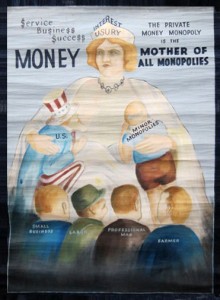 Collins library has acquired a gift from the U.S. Senate Archives – an early 1930’s political themed painting by an unknown artist. Here are some intriguing facts we know about the art piece:
Collins library has acquired a gift from the U.S. Senate Archives – an early 1930’s political themed painting by an unknown artist. Here are some intriguing facts we know about the art piece:
- It was recovered from a crawl space in the attic of the Dirksen Senate Office Building in mid-January 2010.
- It was rolled up inside of a cardboard mailing tube addressed to Senator Homer T. Bone. (1883-1970).
- The return address was “S.E. Cox” in Port Angeles, WA. The staff at the Clallum County Historical Society confirmed that Samuel Earl Cox (1879 – 1945) lived at that address.
- An obituary for S.E. Cox describes him as “a member of the Longshoremen’s Union and prominent in labor circles.”
- Both the postage and the cancellation stamp have been removed, likely by a stamp collector.
- It is an oil on canvas measuring a little more than 2 feet by 3 feet in a portrait orientation.
- Curators from the Smithsonian Political History Division looked at it in June or July of 2010 and agreed that it was in the style appropriate to similar political paintings/posters from 1915-1940.
- There is no date or signature on the painting. It was mailed from the Cox residence, but cannot definitely determine the identity of the actual painter.
- Senator Bone was elected to the Senate as a Democrat, but had previously run as a Socialist, Farmer-Labor, and a Republican candidate.
- The Senator was an attorney in the Tacoma area specializing in labor law.
- He had served as the lawyer for the Longshoremen’s Union during the 1919 strike and later as the attorney for the Port of Tacoma.
- Senator Bone was strong supporter of FDR and the New Deal policies. His trademark issue was public ownership of utilities.
- He had delivered a campaign speech in Port Angeles in October 1932.
- FDR and Senator Bone toured the Olympic Peninsula by car in 1937.
- Best interpretation of the painting’s message,”the big money (banking) monopoly suckling Uncle Sam (federal government) and the minor monopolies (railroads, mining, industry, etc.) while ignoring the middle class (small businessmen, laborers, farmers)”. This message falls squarely in line with the social progressive grassroots movement that brought FDR (and Bone) to office in the election of 1932 and the spurred the New Deal legislation of 1933 and 1934.
- Senator Bone took office in March 1933 and most of the major financial reform legislation was concentrated in FDR’s “First One Hundred Day”, March to June 1933. This included the Glass-Steagall Act, National Industrial Recovery Act, and the legislation regarding the Gold Standard.
- It is assumed that the painting was probably created sometime around or after the October 1932 campaign speech in Port Angeles, but not later than June 1933 when the major financial reforms were enacted.
- The artist may have been Cox, a member of the Cox family, a friend of Cox, a fellow longshoreman, or possibly even a Bone for Senate supporter (we have no information on Cox’s involvement with the campaign) – but definitely someone with strong social progressive opinions of the banking industry.

Just wondering, how did Collins Library end up with the painting?